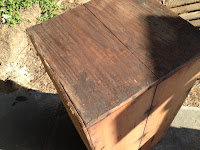I found another old shelf that could be upcycled for storage in our son's room. I'm trying to add more 'in process' photos to these posts so here goes.
The shelf was covered in a dull brown paint and was in pretty beat-up condition. As I was cleaning it up, I noticed raised nails and some weird kind of staples. The former were easy enough to pound in but the latter required a lot of careful filing. There's a lot of ways to join wood, I recommend choosing anything other than protruding metal.
I started stripping with a random orbit sander and then switched to the belt sander as the brown paint was very thick and strong. The shelf unit wasn't assembled very well and there were a lot of uneven surfaces and protruding points. It broke a belt on the belt sander and started shredding a disk on the random orbit sander. Nice. What I should have done was primed over the brown paint, added a top coat of white, spot sanded and stained the whole thing. That would have given me an antiqued look with a nice patina of brown, stained white and stained bare wood.
Alas, I was committed and decided to bring out the heavy artillery. Chemical stripper is great for uneven surfaces but is a real mess to work with. The stripper took off 90% of the brown paint, leaving a couple standing blotches and a brown color to the wood. Spot sanding took care of both of these issues.
After all the difficulty with the outer surfaces, I figured there was no way I was going to get the brown paint off the inside. I did a quick sanding to rough things up, put on a layer of primer and finished with a new coat of brown paint. The outside was stained and is drying overnight. Tomorrow, I'll decide if it needs a second coat and start with the polyurethane.
 I'll be cladding the sides and front of my unit in pallet wood, repainting the inside and adding a stained wood top. The first step was to run some pallet wood through the jointer and cut to length. In this case I'll probably be gluing the jointed edge to the shelf and allowing the uneven surfaces to create some texture (opposite of what I did with the smaller shelf unit). The next step is to clean up all these boards with the jointer or a sander and decide which ones get painted and which stained.
I'll be cladding the sides and front of my unit in pallet wood, repainting the inside and adding a stained wood top. The first step was to run some pallet wood through the jointer and cut to length. In this case I'll probably be gluing the jointed edge to the shelf and allowing the uneven surfaces to create some texture (opposite of what I did with the smaller shelf unit). The next step is to clean up all these boards with the jointer or a sander and decide which ones get painted and which stained.












